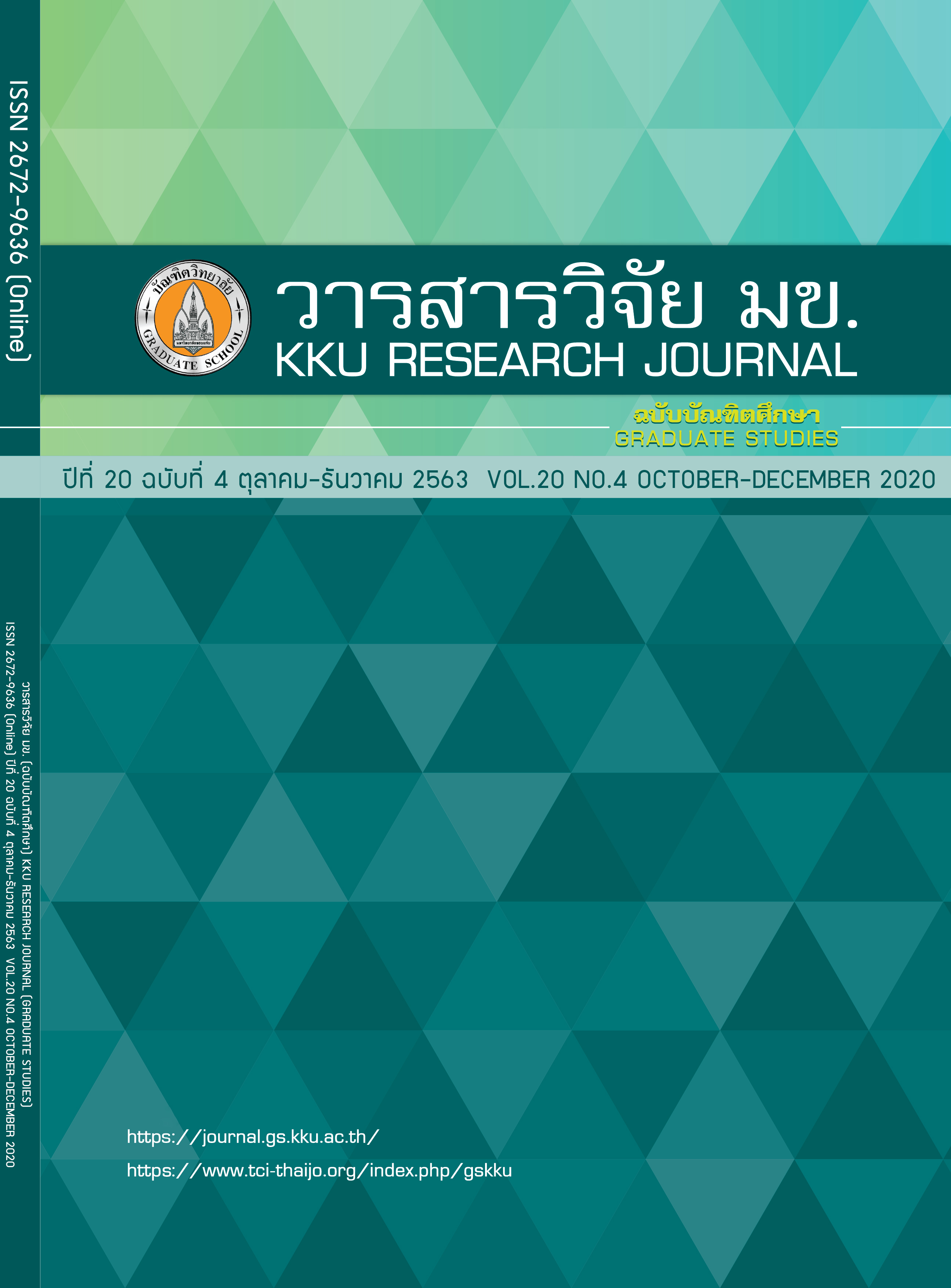การดูดซับฟีนอลในสารละลายโดยใช้ถ่านเปลือกทุเรียนที่ถูกกระตุ้นทางเคมี
คำสำคัญ:
ถ่านเปลือกทุเรียน, ฟีนอล, การดูดซับบทคัดย่อ
ทำการศึกษาศักยภาพการดูดซับฟีนอลของถ่านเปลือกทุเรียนในรูปแบบต่างๆ ทำการทดลองแบบแบทซ์เพื่อศึกษาปัจจัยของ ประเภทถ่าน 12 ชนิด (ถ่านที่ไม่ผ่านการกระตุ้นชนิดเม็ด เกล็ด และผง, ถ่านชนิดเม็ด เกล็ด และผงที่ถูกกระตุ้นด้วย ZnCl2, H3PO4 และ KOH), ความเข้มข้นเริ่มต้นฟีนอล, ระยะเวลาสัมผัส, พีเอช และไอโซเทอร์ม ถ่านแบบผงที่ถูกกระตุ้นด้วยโพแทสเซียมไฮดรอกไซด์ให้ประสิทธิภาพการดูดซับ (ร้อยละ100) ดีกว่าถ่านอีก 11 ชนิด สภาวะที่เหมาะสม (10 มก./ล., พีเอช 5 และ ระยะเวลาสัมผัส 120 นาที) รูปแบบการดูดซับสอดคล้องกับไอโซเทอร์มของฟรุนดิช นอกจากนั้นได้ประยุกต์ใช้ถ่านแบบผงที่กระตุ้นด้วยโพแทสเซียมไฮดรอกไซด์กำจัดฟีนอลในสารละลายที่มีความเข้มข้นในช่วงน้ำทิ้งอุตสาหกรรม (30, 100, 300 และ 800 มก./ล.) ผลการทดลองพบว่าทุกความเข้มข้น ฟีนอลถูกกำจัดร้อยละ 84.91, 85.48, 87.05 และ 89.79 ตามลำดับ ดังนั้นถ่านแบบผงที่กระตุ้นด้วยโพแทสเซียมไฮดรอกไซด์จึงมีศักยภาพเพียงพอในการกำจัดฟีนอลในสารละลาย
References
Suchada C. Antiseptic Phenolic [Internet]. 2008. [updated 2008 December 9; cited 2019 October 31]. Available from: http://www.chemtrack.org.
Ministry of Science Technology and Environment. Specific type of factory and industrial estate as the hazardous waste source which need to be control the waste water before released; 1996 Aug. 5 p.
Kaouah F, Boumaza S, Berrama T, Trari M, Bendjama Z. Preparation and characterization of activated carbon from wild olive cores (oleaster) by H3PO4 for the removal of Basic Red 46. Journal of Cleaner Production. 2013; 54: 296-306.
Tan IA, Ahmad AL, Hameed BH. Preparation of activated carbon from coconut husk: Optimization study on removal of 2, 4, 6-trichlorophenol using response surface methodology. Journal of Hazardous Materials. 2008; 153: 709-717.
Saka C. BET, TG–DTG, FT–IR, SEM, iodine number analysis and preparation of activated carbon from acorn shell by chemical activation with ZnCl2. Journal of Analytical and Applied Pyrolysis. 2012; 95: 21–24.
Yagmur E, Tunc M, Banford A, Zeki A. Preparation of activated carbon from autohydrolysed mixed sou-thern hardwood. Journal of Analytical and Applied Pyrolysis. 2013; 104: 470-478.
Chu W. Dye Removal from Texile dye Wastewater using Recycle Alum Sludge. Water Research. 2001; 32(13): 3147-3152.
Budsaba S, Padcharee P, Wittaya R. Adsorption of Phenol from aqueous solution by zeolite NaY synthesized from rice husk, Program in Chemistry, Faculty of Education, Nakhon Ratchasima Rajabhat University, Thailand. 2015.
Juwannee S. Feasibility study of corneob to remove phenolic compounds in wastewater [MS thesis]. Songkla: Prince of Songkla University; 2004. Thai.
Kusumal L. Removal of Phenolic Compounds by Palm Oil Mill Wastewater Treatment Plant and Land Treatment [MS thesis]. Songkla: Prince of Songkla University; 2014. Thai.
Theeradit P. Activated Carbon from Agricultural Residues by Chemical Activation for the Application of Pollutant Removal in Water. J. Res. Unit Sci. Technol. Environ. Learning. 2017; 8(1): 196-214. Thai.
Amin N.K. Removal of reactive dye from aqueous solution by adsorption onto activated carbon prepared from sugarcane bagasse pith. Desalination. 2008; (223): 152-161.
Kaouah F, Boumaza S, Berrama T, Trari M, Bendjama Z. Preparation and characterization of activated carbon from wild olive cores (oleaster) by H3PO4 for the removal of Basic Red 46. Journal of Cleaner Production. 2013; 54: 296-306.
Prasong A. Treatment of Wastewater Contaminated with Cr (VI) by Adding Powdered Activated Carbon in the Activated sludge Process [MS thesis]. Bangkok: Kasetsart University; 2002. Thai.


